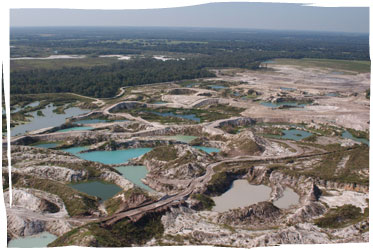The Mining Process

The mining process in Florida begins with a field study to determine the location and density of the phosphate deposits. Information like the location, size, and shape of the ore is determined to focus the mining effort. Hundreds of boreholes are drilled and thousands of core samples studied and tested to gather information about the ore-body. These data are used to determine economic viability of a potential mining area as well as the best way to mine it and how long it will take.
Before digging can begin, and state and federal permits issued, an environmental impact study must be completed. The phosphate companies are required to develop plans to restore the land. The plans must be in place BEFORE mining begins, to mitigate for the damage mining will cause. This plan includes studies of native vegetation and wildlife present in the area, bonding money set aside for completion of reclamation activities as well as the preparation of sites for overburden storage. When the permitting process is complete, mine construction begins, including road building to the site.
In Florida, the phosphate rock is extracted by a process referred to as strip-mining. Unlike mining in other states, phosphate deposits are found closer to the surface, about 30-40 feet below ground. Sandy topsoil, also known as overburden, is removed by large digging machines called draglines. The draglines can remove from 20 - 65 tons of overburden per dig, leaving 215 ft.-wide paths behind. The phosphate is contained in a layer underneath the topsoil, called the matrix. Matrix is a mixture of phosphate rock, sand, and clay. Once the phosphate rock is extracted from the matrix, it is turned into a slurry mixture and sent to manufacturing plants for processing. A typical Florida phosphate mine gets about 9,000 tons of phosphate rock per acre of land